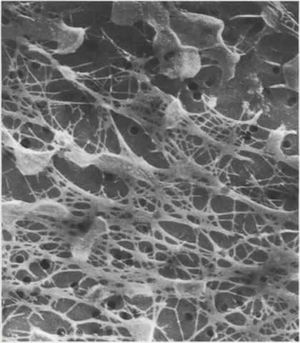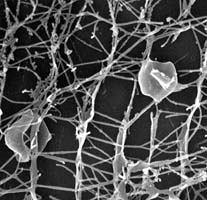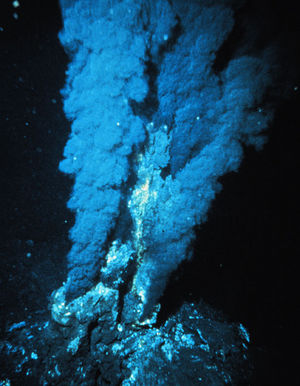Pyrodictium
|
NCBI: |

Classification
Higher order taxa:
Archaea, Crenarchaeota, Thermoprotei, Desulfurococcales, Pyrodictiaceae
Species:
Pyrodictium abyssi, P. brockii, P. occultum
Description and Significance
Pyrodictium is a genera of submarine hyperthrmophilic archaea whose optimal growth temperature ranges from approximately 80oC-105oC. They have a unique cell structure involving a network of cannulae and flat, disk-shaped cells. Pyrodictium are found in the porous walls of deep-sea vents where the temperatures inside get as high as 300o-400oC, while the outside marine environment is typically 3oC. Pyrodictium is apparently able to adapt morphologically to this type of hot-cold habitat.
Genome Structure
Much research has been done on the genetics of Pyrodictium in order to understand its ability to survive and even thrive in such extreme temperatures. The thermal stability of Pyrodictum occultum's isolate tRNA has been analyzed, indicating that modifications in the nucleosides allow the organism to withstand temperatures well over 100o C.
Cell Structure and Metabolism

Pyrodictium cells have been studied by scientists in part because they are a model of thermal stability. The cells' structure is a flat, irregular disk, 0.3 - 2.5 microns in diameter and up to .3 microns in width. The cells grow in unique flake-like shapes held together by a network of hollow cannulae (tubules). The cannulae branch out and connect with other cells, greatly extending their range. While the exact reason for this morphology is unknown, it is likely that the range of motion provided by the cannulae allow the cells to move freely when by the thermal energy from the extreme heat of the organisms's environment. The large size range of the cells may allow Pyrodictium to inhabit a variety of pores in the deep-sea vent walls.
Ecology
Members of Pyrodictium are located in deep-sea hydrothermal vents, first discovered in 1979. Their ecological significance remains a mystery because of the difficulty in collecting samples which may yield data on the abundance and diversity of these extremophiles.

References
Barns, Sue et al. Crenarchaeota. Tree of Life Web Project. 1997.
Euzeby, J.P. Genus Pyrodictium. LPSN. Updated May 14, 2005.
Stetter, Karl O. Smallest Cell Sizes Within Hyperthermophilic Archaea. National Academy of Sciences.
